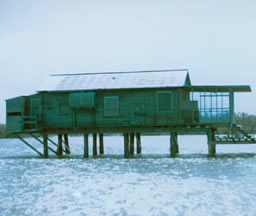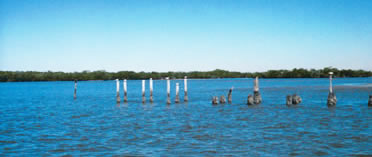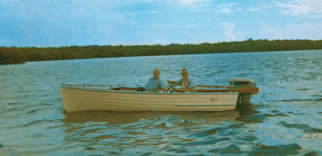December 01, 2005
By Donald Wood
Reflections on an Everglades family fishing camp.

An old icehouse dating back to the 1920s was remodeled inot this weekend fish camp for family and friends. |
On the south side of Fakahatchee Bay, deep in the Florida Everglades, is a set of very old pilings. Nautical charts reveal little about the site, labeling it simply as “ruins.” One source notes there's pretty good redfish and snook action here.
I've always known those pilings had stories to tell. This year, I set out to record some of them. I spent a considerable part of my youth on Fakahatchee Bay, boating, fishing and learning about life at a wilderness outpost steeped in Florida history.
It started in the 1920s, when a group of industrious men began placing two sets of pilings in the mud on the south side of Fakahatchee Bay. The location was only a few hundred yards from the fishing community on Fakahatchee Island at the mouth of Fakahatchee Pass. The pilings would support two structures, the southernmost being a fish house with two walk-in iceboxes to hold fish (presumably, mostly mullet) for transport to Everglades City. The second structure slightly to the north was gone prior to 1948. I assume it housed workers for the fish house and wonder if it was a victim of the 1935 hurricane that devastated South Florida. On the east side of the fish house was a large sliding door with a boom used for loading ice and unloading boxes of fish.
During the late '20s through the early to mid '40s, a thriving fishing community developed on Fakahatchee Island. The community included the well-documented cemetery, numerous homes and even a schoolhouse. There were two families still living on the island in the early '50s. Today, the island is uninhabited.
Fish stored in the ice house were picked up twice weekly and taken to Everglades City. The Atlantic Coast Line railroad had completed a line into Everglades City in the '20s. This last stretch was called the “Deep Lake Railroad,” 14 miles long and eventually connected at Haines City to the lines to the major metropolitan areas of the north. This link to the northern markets was most prosperous during the Great Depression that began in 1929. The line eventually closed in the mid '50s and the Seafood Depot restaurant now sits in the area of the old station (it's a nice place to eat when you visit Everglades City).
In 1948, a jockey named Albert Snider rode a horse named Citation to victory in the Flamingo Stakes at Hialeah Race Track. Sadly, it was the last race he would ever run as six days later he went fishing on Florida Bay with two friends and never returned. No one knows what happened on the fateful night of March 5, 1948, when a ferocious storm rocked the Everglades with torrential rain and 50 mph winds. A huge search-and-rescue effort failed to locate the men. Footprints were found on a beach near Everglades City and the search expanded. My father was involved in the search at that time and hired a local guide for assistance. The skiff was found eight days later overturned on an island 10 miles south of Everglades City. A friend of Al Snider's named Eddie Arcaro eventually rode the horse Citation and won the Triple Crown.

Pilings, as seen today, were all that remained after a lightning strike 1964. The camp was unoccupied at the time of the fire. |
It was during this search effort that my father returned and talked of seeing flamingos and an abandoned fish house in Fakahatchee Bay. (The flamingos actually turned out to be spoonbills that I will discuss later.)
Up until this time we had spent many weekends and summer vacations fishing out of Gordon's Pass Fish Camp in Naples. We fished primarily spring and fall for mackerel and snook in the summers. Both could be sold at the time, which helped offset the cost of the trips. We would round up fiddler crabs on sheets and collect a garbage can full to use with canepoles for sheepshead. It was a great life, but as the Naples area became more crowded (by my father's standards at the time) the remoteness of that abandoned fish house in Fakahatchee Bay was too alluring to ignore. He was able to trace its ownership to Riggs Fish Company in Fort Myers. He, my uncle Tom and two close friends leased the facility for a short period and eventually purchased it in 1950.

The author shares a recent photo of a big snook, along with memories of days and nights spent in the Everglades. |
The first chore was the removal of the two iceboxes to enlarge the living and sleeping areas. A linoleum floor was installed along with four bunk beds, a dining table and eight chairs in the main room. The kitchen area was equipped with cabinets for dishes and cookware, a sink, propane stove and refrigerator. Coleman lanterns were used for lighting at night for several years until more sophisticated propane lights were installed. A large (several hundred gallon) tank was installed on the west side to collect rainwater off the tin roof, which was in good shape, for showering and washing dishes. Bathroom facilities were very simple, consisting of a toilet seat and letting the catfish take care of the rest. Bottled drinking water and propane were brought in as needed. A screened porch and enlarged boat dock were built on the south end.
All supplies had to be hauled in from Everglades City, some six miles east. My dad, uncle and one other partner all owned 16-foot Lyman boats powered by 25- or 35-horsepower Evinrude outboards. They used these little boats to carry supplies, and to tow wooden skiffs tied together and laden with heavier items such as lumber, mattresses, stove, refrigerator and water tanks. All of this had to be towed at high tide only across Lane Cove, through West Pass Bay, Gate Bay and finally Fakahatchee Bay to the camp. A local resident of Fakahatchee, named J.P., rowed his skiff everywhere he went and at the time we were expanding the dock, he helped by rowing up the Fakahatchee River and cutting a dozen 15-foot black mangrove trees to use for posts. They are still there today.
In less than a year, they had built a functional fishing camp. Life here was quite comfortable, even in the heat of summer, being cooled by natural breezes and evening thu
nderstorms. At night we would often be serenaded by light rain on the tin roof. It would lull you to sleep so peacefully while you dreamed of big snook to be caught in the morning. I have to admit when the breezes stopped, the mosquitoes would be intense and oily 6-12 was the best repellent available. (Off, Cutter and Yard Guard would have been great!)
In the evenings after supper, we played poker and blackjack, frequently with a shark line tied off the dock baited with a dead ladyfish or jack. Large blacktip sharks were easy prey. One of the really nice things about the camp in those days was the fact that we never locked the cabin door. A sign on the door read: “Feel welcome to use this facility as emergency shelter if needed, and if you need to borrow fuel or any other item, please replace as soon as possible Signed: Fakahatchee Yacht Club.” I can't remember ever having any items stolen.
As for the fishing, I probably remember the good times and try to forget the slow periods. We had many of the same things we see today: good years, poor years, red tides, windy days, muddy water. Memory tells me that small snook (less than 10 pounds) were much more plentiful throughout the area, but I think we actually catch more really large snook today. I guess that could be due to better tackle and line.
When the red Ambassadeur 5000 became available with its smooth star drag, it rapidly became standard tackle. Large schools of redfish and trout were certainly more common back then. One year, bull redfish covered Fakahatchee Bay and were a blast to catch on Creek Chub's topwater Yellow Darters. For a year or two the Dying Quiver was the plug of choice for snook. Dandy Lures (both topwater and slow sinkers) were steady producers as were the blue Zara Spook and 52M11 MirrOlure, much as they are today. It seems that most of the tarpon were just too big and mean for our tackle, as most of our stories highlighted the ones that got away. One of the major differences fishing in those days was the smaller boats and no trolling motors, jack plates or power lifts. Fishing for snook generally involved plug-casting shorelines and oyster bars while drifting with the wind or tide and adjusting the boat position with a pair of oars. Dad usually insisted he man the oars while my brother and I fished. He would always keep a rod at his side rigged with an Upperman bucktail jig. If someone got a short strike, he would quickly flop that jig right at the spot, let it sink and invariably—Fish on!
The environment was certainly pristine and beautiful and there were very few boats around. However, there are some things much more plentiful today than back then. In the '50s and early '60s if anyone at the camp saw a manatee it was a major sighting that we would talk about over dinner and for days to come. We were amazed that sea cows, as we called them, were so enormous and gentle. It is also great to see the ospreys back in good numbers. And bald eagle sightings were unheard of back then. The roseate spoonbills that Dad at first thought were flamingos in 1948 have used that same cut as a roosting area in the summer for over 50 years. One thing that has changed, and I really miss it, is the rookery that was present in the '50s on a chain of islands just north of the camp in the middle of Fakahatchee Bay. Every evening, literally thousands of birds would return to roost for the night. The predominant species was certainly the white ibis and they were joined by American egrets, snowy egrets, great blue herons, Louisiana herons, little blue herons, cormorants, brown pelicans and I am sure others I have failed to mention. The young white ibis (brown in color) were called curlew and were a prime source of food at the time. As best I can remember it ceased being a primary rookery in the '60s.

One of the small fishing boats, circa 1950, used to haul supplies and construction materials from Everglades City. |
Changes to the islands have occurred slowly over the years. The large oyster bar on the west side of the camp has filled in to the south and grown to the north, resulting in the main bar now being 150 to 200 yards north of where it once was. For 40-plus years there were no mangroves growing on the bar, but in the last 10 years, several have taken hold and I suppose one day in the future a new island will form. Other changes can occur quite quickly, such as the closing of the cut behind Camp Lulu Key—an outer island on the Gulf of Mexico—that happened in less than two years.
It was obvious that our camp had survived many hurricanes through the years, including one of the most severe ever, in 1935. In 1960, we discovered how it had apparently survived. Following Hurricane Donna, a bad one, we went to see what was left of the camp. After navigating through the numerous bays and around the downed trees, we entered Fakahatchee Bay and there she was, standing as proud as ever. When we entered the camp, the secret of its survival was revealed. The floor was covered with mud and the refrigerator had floated up and against the wall and settled on its side. Apparently, the high water flooded the camp, protecting it from the direct effect of 125 mph winds. With a little cleaning up we were as good as new.
We always feared that lightning would someday bring an end to our wonderful camp, but took comfort in the fact that it obviously had survived many thunderstorms in its 40-plus years of existence. We sat through many electrical storms away from the walls and with our feet off the floor. I'm not sure what good that would have done.
In 1964, Mom, Dad and I planned to take my girlfriend (now my wife of 40 years) to the camp on a Friday afternoon to spend Labor Day weekend. As it turned out, she had to work Friday night and we didn't go until Saturday. I was running the boat that fateful day when we entered Fakahatchee Bay and came around the rookery where we would first see the camp. It was gone. I remember Dad not wanting to believe his eyes, but all that was left were pilings still smoking. A local mullet fisherman told us there had been a terrible thunderstorm the night before and they had heard several loud explosions from the area of the camp—the propane and gas tanks.
I wonder to this day if we had been there, would we have died in the inferno or would we have been able to save the camp? I have to assume God saved us a tragic death. Mom and Dad are long since gone, but every now and then I'll just tie my boat to one of the remaining pilings of “The Ruins” to watch the sun set and remember them and the many great times growing up and enjoying the Fakahatchee Yacht Club.
FS
